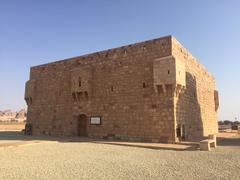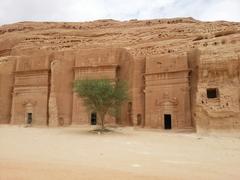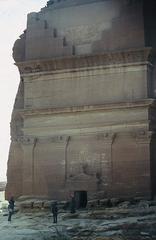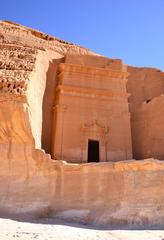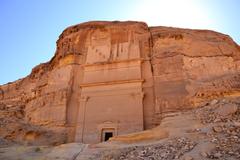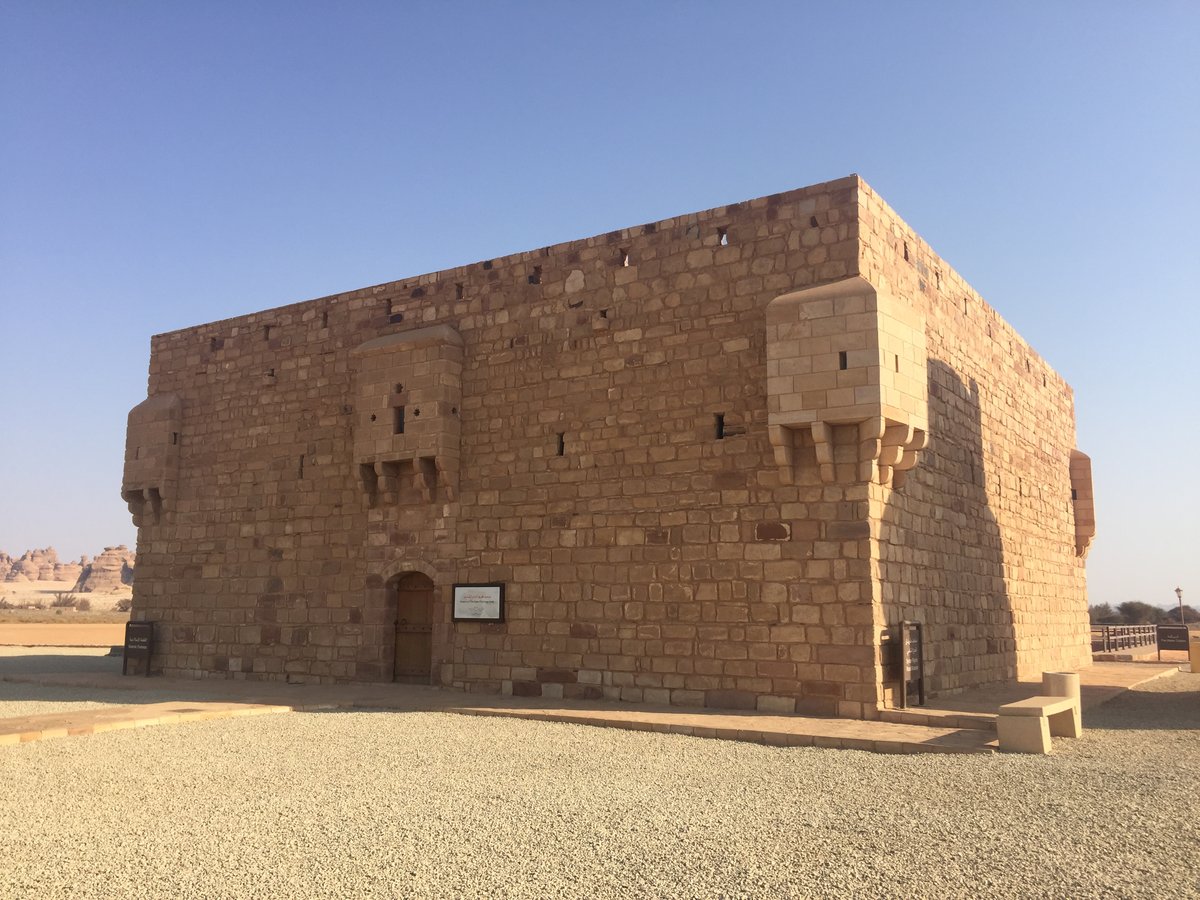
Al-Hijr Castle Visiting Hours, Tickets, and Medina Historical Sites Guide
Date: 15/06/2025
Introduction to Al-Hijr Castle and Its Significance
قلعة الحجر (Al-Hijr Castle), also known as Mada’in Saleh or Hegra, is one of Saudi Arabia’s most extraordinary archaeological sites. Located in the lush Al-Ula valley of Medina Province, it is the country’s first UNESCO World Heritage Site and a testament to the ancient Nabataean civilization. Over 130 monumental tombs, carved into rose-colored sandstone cliffs, showcase the Nabataeans’ architectural genius and their mastery of water management, vital for supporting the city’s role as a southern hub on the incense and spice trade routes. Al-Hijr’s importance extended beyond the Nabataeans, with significant Islamic and Ottoman-era layers—including an 18th-century fort built by Ottoman governor As’ad Pasha al-Azm to protect Hajj pilgrims, and its integration into the Hejaz Railway (WorldAtlas, TravelPander, Saudipedia, WorldHeritageSite.org).
Today, visitors to Al-Hijr can explore iconic structures such as the unfinished Qasr al-Farid, enjoy guided tours, participate in cultural festivals like Winter at Tantora, and discover nearby attractions such as Al-Ula Old Town and the Hejaz Railway stations. This guide covers the site’s historical significance, visitor information (including hours and tickets), conservation initiatives, and practical tips for an enriching experience (Experience AlUla, Madain Project).
Contents
- Introduction
- Nabataean Origins and Early Settlement
- Strategic Importance and Trade
- Islamic Era and Ottoman Influence
- Cultural and Religious Significance
- Architectural Features and Artistic Legacy
- Visiting Al-Hijr: Hours, Tickets, and Permits
- Guided Tours and Special Events
- Photography and Best Spots
- Accessibility and Travel Tips
- Conservation and Modern Rediscovery
- Internal and External Resources
- Frequently Asked Questions (FAQ)
- Conclusion and Call to Action
Nabataean Origins and Early Settlement
Al-Hijr originated as a major Nabataean city in the 1st century BCE–1st century CE. The Nabataeans, famed for their water engineering and rock-cut monuments, made Al-Hijr their southernmost city after Petra. Archaeological evidence shows the site was a bustling center on the incense and spice trade routes, connecting Arabia to the Mediterranean (WorldAtlas, TravelPander). The site’s 130+ tombs are adorned with Egyptian, Assyrian, and Hellenistic influences, with Qasr al-Sanea and Qasr al-Farid standing out for their size and artistry (Madain Project).
Strategic Importance and Trade
Al-Hijr’s prime location transformed it into a trade nexus, supporting caravans transporting frankincense, myrrh, spices, and luxury goods. Its advanced water systems—wells, cisterns, and channels—enabled agriculture and sustained large populations in the desert (NCUSAR). The diverse scripts and motifs found in its tombs underline the city’s cosmopolitan nature (WorldAtlas).
Islamic Era and Ottoman Influence
After the Roman annexation in 106 CE, Al-Hijr declined until it gained renewed importance as a station on the Hajj pilgrimage route. In the mid-18th century, an Ottoman fort was built to protect pilgrims and serve as a marketplace. The early 20th-century Hejaz Railway further established Al-Hijr as a critical pilgrimage and trade stop, and today its station serves as a visitor center (Madain Project, WorldHeritageSite.org).
Cultural and Religious Significance
Al-Hijr is mentioned in the Quran, associated with the people of Thamud who were punished for idolatry (Matador Network). This reputation led to centuries of limited visitation, but modern efforts have repositioned the site as a cultural treasure open to all. UNESCO recognized Al-Hijr for its outstanding preservation and historical value in 2008 (TravelPander, WorldHeritageSite.org).
Architectural Features and Artistic Legacy
The monumental tombs of Al-Hijr display intricate facades with columns, cornices, and motifs reflecting the Nabataeans’ artistic blending of cultures. Qasr al-Farid, the unfinished “Lonely Castle,” is especially striking and provides insight into ancient construction techniques. Inscriptions across the site offer valuable information about the people who once lived and traded here (WorldAtlas, WorldHeritageSite.org).
Visiting Al-Hijr: Hours, Tickets, and Permits
- Hours: 8:00 AM–6:00 PM daily (seasonal variations may apply).
- Tickets: Purchase online via the official Experience AlUla platform or at the entrance. Permits are included with ticket purchases.
- Tour Options: Guided tours are recommended for deeper insight into the site’s history.
Guided Tours and Special Events
Guided tours in multiple languages cover the major highlights, including Qasr al-Farid, Qasr al-Sanea, and the Hejaz Railway. The Winter at Tantora festival offers exclusive access, night tours, and cultural events for a unique experience.
Photography and Best Spots
Photography is permitted (with some restrictions on drones and flash). The best times are sunrise and sunset. Qasr al-Farid, Jabal al-Mahjar, and the Ottoman fort are standout locations for photos.
Accessibility and Travel Tips
While paved paths and shuttle services are available, some areas may be challenging for those with mobility impairments. Visitors should wear comfortable shoes, bring water, and visit during October–March for the best weather. Transport from AlUla is via guided buses or car rentals. Up-to-date advisories are found on official tourism websites.
Conservation and Modern Rediscovery
After its archaeological identification in 1972, Al-Hijr saw significant conservation efforts. The Royal Commission for AlUla (RCU) leads preservation, sustainable tourism, and community engagement initiatives. Access is regulated, and guided tours help preserve the site (Travellino, NCUSAR, WorldHeritageSite.org).
قلعة الحجر (Hegra Castle): Detailed Architectural Features
Location and Historical Context
قلعة الحجر, also called Hegra Castle, is located on the northern side of the Hegra archaeological site along the Levantine Hajj Road. It reflects both Nabataean and Ottoman-era architecture (Saudipedia).
Design and Layout
- Structure: Square plan, 8.35-meter-high walls, built in the Ottoman style.
- Watchtowers: Main entrance with a large watchtower; four corner towers.
- Courtyard: Central open space surrounded by rooms for administration and accommodation.
- Prayer Rooms: Two, on ground and upper levels.
- Wells: One in the courtyard, another to the east.
- Materials: Local sandstone, thick masonry for insulation and protection.
Visitor Information: قلعة الحجر
- Hours: 8:00 AM–6:00 PM, last entry an hour before closing.
- Tickets: SAR 50 (general), SAR 30 (Saudis/GCC residents), free for children under 12. Buy online or at the visitor center.
- Accessibility: Paved pathways and shuttles; upper floors may be difficult for those with mobility issues.
- Tours: Classic Land Rover tours, horse-drawn carriage rides, and audio-guided shuttles.
Conservation Efforts
Hegra, including قلعة الحجر, is part of UNESCO’s World Heritage List and the Saudi Cultural Heritage Program, with the RCU overseeing restoration, scientific studies, and sustainable tourism. Initiatives include structural stabilization, documentation, community training, and environmental protections like the Sharaan Nature Reserve. The “Journey Through Time” masterplan envisions 15 new cultural facilities and sustainable development for AlUla (UNESCO, Saudi Archaeology, Saudipedia).
Nearby AlUla Attractions
- Nabataean Tombs: Over 100 monumental tombs at Hegra.
- Hejaz Railway Station: Early 20th-century station with exhibits.
- AlUla Old Town: Mudbrick settlement and fortress.
- Dadan and Jabal Ikmah: Pre-Nabataean ruins and inscriptions.
- Jabal Al-Fil (Elephant Rock): Iconic sandstone formation.
- Oasis Heritage Trail: Walks through palm groves and ancient irrigation channels.
(Experience AlUla, Experience AlUla, Experience AlUla)
Medina Historical Sites
- Al-Masjid an-Nabawi: Islam’s second holiest mosque.
- Quba Mosque: World’s oldest mosque.
- Mount Uhud: Historic battlefield.
- Medina Souks: Traditional markets and cuisine.
(nomadicsamuel.com, thrillophilia.com, myholidays.com, audiala.com)
Visitor Tips
- Plan ahead: Book tickets and tours in advance, especially October–March.
- Dress Code: Modest clothing. Women not required to wear abaya but should cover shoulders and legs.
- Hydrate and protect from sun: Bring water, sunscreen, and a hat.
- Respect customs: Avoid public displays of affection; be mindful during prayer times and Ramadan.
- Accessibility: Some terrain is uneven; main facilities are accessible.
- Safety: Watch for uneven surfaces; supervise children; emergency numbers are 997 (ambulance) and 999 (police).
Frequently Asked Questions (FAQ)
Q: What are the visiting hours for Al-Hijr and قلعة الحجر?
A: Hours are typically 8:00 AM–6:00 PM, but check official sites for seasonal updates.
Q: How do I buy tickets?
A: Online via Experience AlUla or at the visitor center.
Q: Are guided tours available?
A: Yes, and they are highly recommended for historical context.
Q: Is the site accessible for people with disabilities?
A: Main paths and facilities are accessible; some historic areas have stairs or uneven ground.
Q: What is the best time to visit?
A: October–March for comfortable weather and special events.
Q: What other attractions are nearby?
A: Nabataean tombs, AlUla Old Town, Hejaz Railway, Dadan, Jabal Ikmah, Elephant Rock.
Conclusion and Call to Action
Al-Hijr and قلعة الحجر offer a unique journey through millennia of Arabian history, from Nabataean splendor to Islamic and Ottoman heritage. Plan ahead for your visit—secure tickets, join a guided tour, and experience cultural festivals for a deeper connection to this UNESCO World Heritage Site. Download the Audiala app for interactive guides and updates, and follow official channels for the latest news and conservation initiatives. Embark on your own discovery of Saudi Arabia’s archaeological and cultural treasures.
References
- Al-Hijr Mada’in Saleh Historical Places of Saudi Arabia (WorldAtlas)
- Exploring Al-Ula City (TravelPander)
- قلعة الحجر (Hegra Castle) History and Architecture (Saudipedia)
- Hegra UNESCO World Heritage Listing (UNESCO)
- Visiting Al-Ula and Mada’in Saleh (NCUSAR)
- Madain Saleh Archaeological Project (Madain Project)
- Hegra Archaeological Site Details (WorldHeritageSite.org)
- Experience AlUla Official Tourism Information (Experience AlUla)
- Travel Tips and Cultural Etiquette in Saudi Arabia (Traveloka)
- قلعة الحجر Location and Access (Wikipedia, Destination KSA)
- قلعة الحجر Facilities (Soudipedia)
- Ibn Battuta Travel (Ibn Battuta Travel)
- Dos and Don’ts in Saudi Arabia (Annmarie John)
- Hegra Archaeological Site (worldheritagesites.net)
- Hegra: The Archaeological Site of Al-Hijr (artsandculture.google.com)
- AlUla Experiences (experiencealula.com)
- Nomadic Samuel’s Medina City Guide (nomadicsamuel.com)
